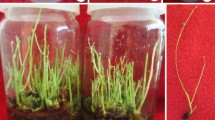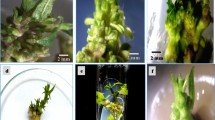Abstract
Present study reports successful in vitro clonal propagation of a potential medicinal plant, Cassia alata using mature nodal explants. Murashige and Skoog (MS) medium supplemented with different concentrations (0.5, 2.5, 5.0, 7.5, 10.0 and 12.5 μM) of 6-benzyladenine (BA), kinetin and 2-isopentenyl adenine (2-iP) singly as well as in combination with different auxins, α-naphthalene acetic acid (NAA), Indole-3-butyric acid (IBA) or Indole-3-acetic acid (IAA) (0.1, 0.5 and 1.0 μM) were used. MS medium enriched with 7.5 μM BA and 0.5 μM NAA yielded the highest regeneration frequency (92 %) with maximum multiple shoots (12.3 ± 0.6) and shoot length (4.7 ± 0.1 cm) after 12 weeks of culture. Shoots were rooted best on full MS containing 0.5 μM IBA. Ex vitro rooting of in vitro derived microshoots was also achieved in 150 μM IBA treatment for 20 min followed by transfer to thermocol cups containing sterile Soilrite™. About 85 % plantlets survived acclimatization procedure to the field. The genetic fidelity of in vitro regenerated plants was analyzed using random amplified polymorphic DNA (RAPD) and inter-simple sequence repeat (ISSR) markers. Of the 20 RAPD primers, 18 primers produced clear, reproducible and scorable bands while out of 13 ISSR primers screened, only ten generated well-defined and scorable bands in all the tested plants. A total of 69 and 71 bands were scored with an average of 3.8 and 7.1 bands per primer for RAPD and ISSR primers respectively. All banding profiles from micropropagated plants were monomorphic and similar to of the mother plant, thus confirming the true-to-type nature of the in vitro-raised clones.


Similar content being viewed by others
References
Ahmad N, Anis M (2007) Rapid clonal multiplication of a woody tree, Vitex negundo L. through axillary shoots proliferation. Agrofor Syst 7:195–200
Ahmed MR, Anis M (2014) Rapid in vitro propagation system through shoot tip cultures of Vitex trifolia L.- an important multipurpose plant of the Pacific traditional medicine. Physiol Mol Biol Plants. 20:385–392
Ahmed MR, Ahmad N, Anis M, Aref IM (2013a) Efficient plantlet regeneration from cotyledonary node cultures of Cassia alata L. (Ringworm Bush): stimulatory effect of thidiazuron. J Horticul Sci Biotechnol 88:141–146
Ahmed MR, Anis M, Aref IM (2013b) An efficient and reproducible method for in vitro propagation of Cassia alata L.—an important woody medicinal plant. Inter J Pharma Biosci 4:1223–1234
Anand S (2010) Various approaches for secondary metabolite production through plant tissue culture. Pharmacia 1:1–7
Anis M, Varshney A, Siddique I (2010) in vitro clonal propagation of Balanites aegyptiaca L. Del. Agrofor Syst 78:151–158
Anonymous (1992) The wealth of india—raw materials, vol 3. CSIR, New Delhi, pp 354–363
Devarumath RM, Nandy S, Rani V, Marimuthu S, Muraleedharan N (2002) RAPD, ISSR and RFLP fingerprints as useful markers to evaluate genetic integrity of micropropagated plants of three diploid and triploid elite tea clones representing Camellia sinensis (China type) and C. assamica ssp. assamica (Assam-India type). Plant Cell Rep 21:166–173
Doyle JJ, Doyle JL (1990) Isolation of plant DNA from fresh tissue. J Focus 12:3–15
Faisal M, Alatar AA, Ahmad N, Anis M, Hegazy AK (2012) An efficient and reproducible method for in vitro clonal multiplication of Rauvolfia tetraphylla L. and evaluation of genetic stability using DNA-based markers. Appl Biochem Biotech 168:1739–1752
Fett-Neto G, Fett JP, Aquila ME, Ferreira AG (2000) In vitro propagation of Senna alata. Planta Med 66:195–196
Goto S, Thakur RC, Ishii K (1998) Determination of genetic stability in long-term micropropagated shoots of Pinus thunbergii Parl. using RAPD markers. Plant Cell Rep 18:193–197
Goyal P, Jain R, Kachhwaha S, Kothari SL (2015) Assessment of genetic diversity in Pithecellobium dulce (Roxb.) benth. germplasm using RAPD and ISSR markers. Trees 29:637–653
Husain MK, Anis M (2009) Rapid in vitro multiplication of Melia azaderach L. (a multipurpose woody tree). Acta Physiol Plant 31:765–772
Jahan AA, Anis M, Aref MI (2011) Assessment of factors affecting micropropagation and ex vitro acclimatization of Nyctanthes arbor-tristis L. Acta Biol Hung 62:45–56
Javed SB, Anis M, Khan PR, Aref M (2013) in vitro regeneration and multiplication for mass propagation of Acacia ehrenbergiana Hayne: a potential reclaiment of denude arid lands. Agroforest Syst 87:621–629
Joshi P, Dhawan V (2007) Assessment of genetic fidelity of micropropagated Swertia chiraytia plantlets by ISSR marker assay. Biol Plant 51:22–26
Khan MR, Kihara M, Omoloso AD (2001) Antimicrobial activity of Cassia alata. Fitoterapia 72:561–564
Khare CP (2007) Indian medicinal plants: an illustrated dictionary. Springer, Berlin, pp 126–127
Khurana-Kaul V, Kachhwaha S, Kothari SL (2012) Characterization of genetic diversity in Jatropha curcas L. germplasm using RAPD and ISSR markers. Indian J Biotechnol 11:54–61
Kumar S, Mangalm M, Dhawanm AK, Singh N (2011) Assessment of genetic fidelity of micropropagated plants of Simmondsia chinensis (Link.) Schneider using RAPD and ISSR markers. Acta Physiol Plant 33:2541–2545
Lakshmanan V, Venkataramareddy SR, Neelwarne B (2007) Molecular analysis of genetic stability in long-term micropropagated shoots of banana using RAPD and ISSR markers. Electronic J Biotech 10:1–8
Lata H, Chandra S, Techen N, El-Sohly M, Khan I (2013) Determination of genetic stability of micropropagated plants of Stevia rebaudiana using inter-simple sequence repeat (ISSR) markers. Planta Med 78:1–6
Martin M, Sarmento D, Oliveira MM (2004) Genetic stability of micropropagated almond plantlets, as assessed by RAPD and ISSR markers. Plant Cell Report 23:492–496
Murashige T, Skoog F (1962) A revised medium for rapid growth and bioassays with tobacco tissue cultures. Physiol Plant 15:473–497
Parveen S, Shahzad A (2010) TDZ–induced high frequency shoot regeneration in Cassia sophera Linn. via cotyledonary node explants. Physiol Mol Biol Plants 16:201–206
Perveen S, Varshney A, Anis M, Aref MI (2011) Influence of cytokinins, basal media and pH on adventitious shoot regeneration from excised root cultures of Albizia lebbeck. J Forest Res 22:47–52
Razaq M, Heikrujam M, Chetri SK, Agrawal V (2013) In vitro clonal propagation and genetic fidelity of the regenerants of Spilanthes calva DC. using RAPD and ISSR marker. Physiol Mole Biol Plants 19:251–260
Salvi ND, George L, Eapen S (2001) Plant regeneration from leaf base callus of turmeric and random amplified polymorphic DNA analysis of regenerated plants. Plant Cell Tiss Org Cult 66:113–119
Shahzad A, Faisal M, Anis M (2007) Micropropagation through excised root culture of Clitoria ternatea and comparison between in vitro regenerated plants and seedlings. Ann Appl Biol 150:341–349
Siddique I, Anis M (2009) Direct plant regeneration from nodal explants of Balanites aegyptiaca L. (Del.)—a valuable medicinal tree. New For 37:53–62
Siddique I, Javed SB, Al-Othman RM, Anis M (2013) Stimulation of in vitro organogenesis from epicotyl explants and successive micropropagation round in Cassia angustifolia Vahl.: an important source of sennosides. Agrofor Syst 87:583–590
Somchit MN, Reezal I, Nur IE, Mutalib AR (2003) In vitro antimicrobial activity of ethanol and water extracts of Cassia alata. J Ethnopharmacol 84:1–4
Suttle GR (2000) Commercial laboratory production. In: Trigiano RN, Gray DJ (eds) Plant tissue culture concepts and laboratory exercises. CRC Press, Boca Raton, pp 407–416
Varshney A, Anis M (2013) Evaluation of clonal integrity in desert date tree (Balanites aegyptiaca Del.) by inter-simple sequence repeat marker assay. Acta Physiolo Plant 35:2559–2565
Villasenor IM, Canlas AP, Pascua MP, Sabando MN, Soliven LA (2001) Bioactivity studies on Cassia alata Linn. leaf extracts. Phytother Res 16:93–96
Acknowledgments
Md. Rafique Ahmed is thankful to the University Grants Commission (UGC), Govt. of India, New Delhi for the award of Senior Research Fellowship (MANF/UGC). Research support provided by the Department of Science and Technology (DST) in the form of DST-FIST –II (2011–2016) and UGC in the form of SAP-DRS-II (2016–2021) Programme is duly acknowledged.
Author contribution
MR Ahmed designed and carried out the experiments, data collection and wrote the manuscript. AA Alatar and M Faisal helped in data analysis and M Anis guided the whole experiment and made suggestions to the manuscript.
Author information
Authors and Affiliations
Corresponding author
Ethics declarations
Conflict of Interest
Authors declare no conflict of interest. The authors alone are responsible for the content and writing of the article.
Rights and permissions
About this article
Cite this article
Ahmed, M.R., Anis, M., Alatar, A.A. et al. In vitro clonal propagation and evaluation of genetic fidelity using RAPD and ISSR marker in micropropagated plants of Cassia alata L.: a potential medicinal plant. Agroforest Syst 91, 637–647 (2017). https://doi.org/10.1007/s10457-016-9992-1
Received:
Accepted:
Published:
Issue Date:
DOI: https://doi.org/10.1007/s10457-016-9992-1




